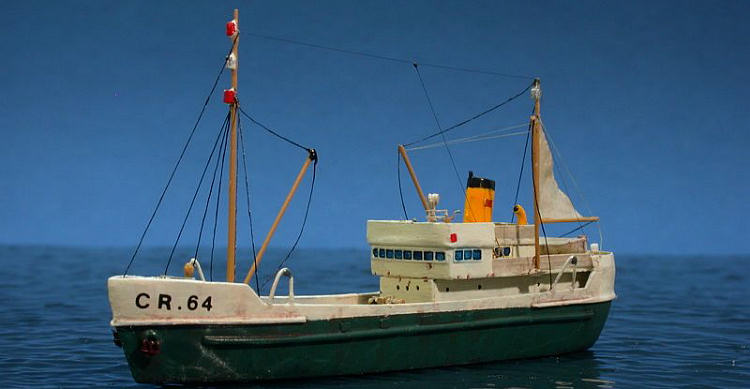
Battlefleet Models 1/700 North Sea Trawler
| KIT #: | BFM 721A |
| PRICE: | $28.00 MSRP |
| DECALS: | None |
| REVIEWER: | Frank Spahr |
| NOTES: | Resin with brass bits. |

| HISTORY |
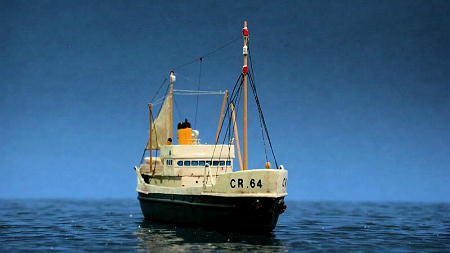 Harry Abbott´s company Battlefleet
Models is bringing life and variety to our workbenches and naval dioramas. His
motto „Where your Auxiliary Fleet comes in“ wraps things up nicely – he is
working on the host of hitherto hardly kitted auxiliary and smaller vessels. He
is always interested in modelers´ suggestions re new kits.
Harry Abbott´s company Battlefleet
Models is bringing life and variety to our workbenches and naval dioramas. His
motto „Where your Auxiliary Fleet comes in“ wraps things up nicely – he is
working on the host of hitherto hardly kitted auxiliary and smaller vessels. He
is always interested in modelers´ suggestions re new kits.
Livia is a generic fishing vessel as
they were built in various countries and for quite some time. Harry used the
book „Steam Coasters“ by Charles Waine as a reference. „Livia“ is based on SS
Maggie as seen on pg. 117. The kit is available in a civilian and military
version, armed with a 3in gun and a 20mm machine gun, to be mounted at the bow
and on the charthouse. Hence, the kit is an excellent base for a plethora of
both civilian and military vessels. Besides normal trawlers, armed trawlers used
as escorts, Soviet spy trawlers, even a Greenpeace vessel or an offshore radio
vessel can be built.
| THE KIT |

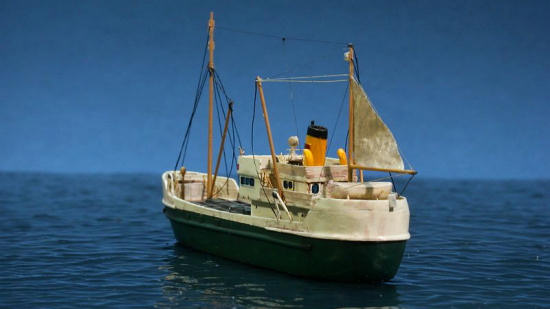
The instructions start with a short description of the subject, followed by safety notes and useful hints at working with the materials provided. The instruction proper is brief, it comprises of a parts list and several photos of the prototype – brief yet entirely sufficient. As it is a generic kit, there are neither painting directions nor decals. I for one regard designing my personal trawler as part of the fun.
| CONSTRUCTION |
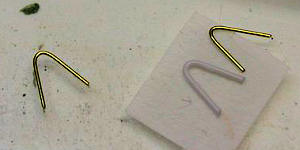 I soon decided to convert my trawler,
even though just a bit. I had a post-war ship with some colour in mind, and soon
found a drawing in Bjoern Landstroem´s classic book „The Ship“. Ill. 777 shows
the 19
I soon decided to convert my trawler,
even though just a bit. I had a post-war ship with some colour in mind, and soon
found a drawing in Bjoern Landstroem´s classic book „The Ship“. Ill. 777 shows
the 19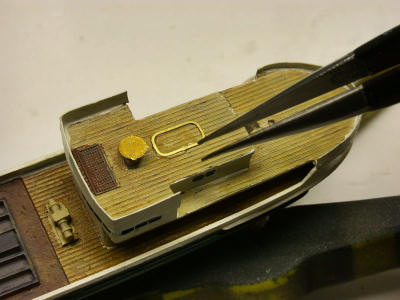 51 British trawler „Hildina“ I very loosely based my conversion on.
51 British trawler „Hildina“ I very loosely based my conversion on.
Hence I added bulkheads atop the
charthouse and the bow, here plastic sheet and CA-reinforced paper were used.
The open bridge received a grating with steering wheel, plus a searchlight
platform. Several inclined ladders and some watertight doors were provided. PE
scuppers, vents from solder plus a brass wire steam pipe were added, too. Again
I found L´Arsénal´s PE sets „Structural Parts 1+2“ plus WEM´s classic sets „Askold“
and „Tiger“ very helpful. They contain all sorts of useful things like boat
cradles, platforms, tiny rectangles and so on.
The masts were made from BMK
conically machined brass plus the brass wire provided in the kit, plus very thin
brass from kotol.de. The navigation lights were made from tiny pieces of solder.
The fishing net derrick supports were made from brass, using the resin parts as
pattern.
| COLORS & MARKINGS |
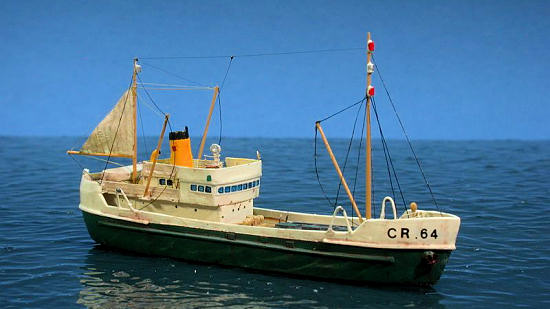 The vessel was painted using acrylics
from various manufacturers. The hull was sprayed, the rest brush-painted.
Washing with artist´s oil paints and some drybrushing
was used to enhance and weather the hard-worked vessel. As always, the
vessel looks worse in the macro images than in real life. The sail was made from
cigarette paper, the rigging is
The vessel was painted using acrylics
from various manufacturers. The hull was sprayed, the rest brush-painted.
Washing with artist´s oil paints and some drybrushing
was used to enhance and weather the hard-worked vessel. As always, the
vessel looks worse in the macro images than in real life. The sail was made from
cigarette paper, the rigging is
The registration was applied using
dry transfers, while a final flat coat sealed and blended things in.
| CONCLUSIONS |
This is a high-quality kit all around, and it is almost complete. The subject is very useful and invites all sorts of conversions. This small kit will be especially well suited for beginners with resin kits, as it is fairly simple and straightforward – and the high quality of the casting will spare the beginner some of the more nasty resin experiences. I hope we will see a number of entirely different built models soon. Highly recommended!
August 20009
If you would like your product reviewed fairly and quickly, please contact me or see other details in the Note to Contributors.